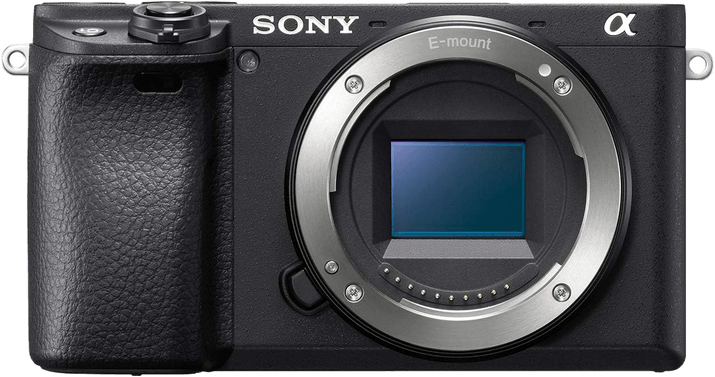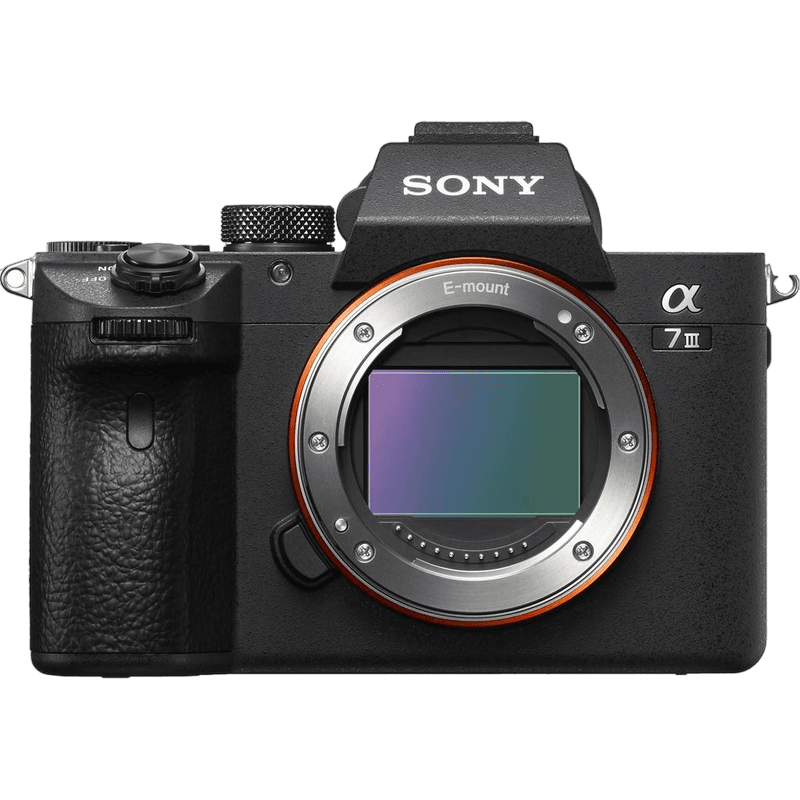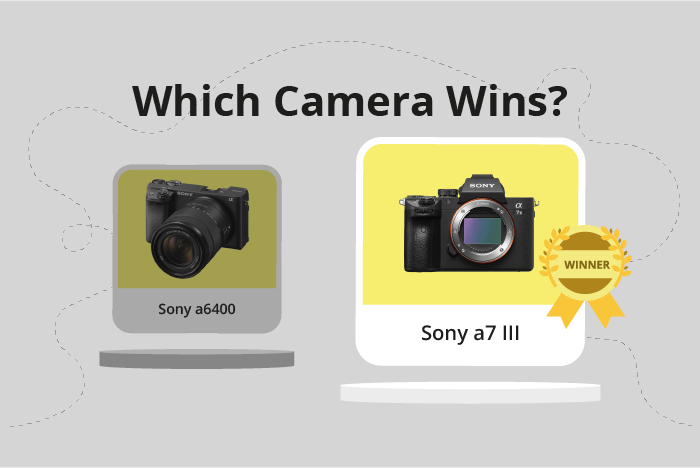Sony a6400 vs a7 III Comparison
Sony a6400

Sony a7 III

The Sony a7 III outperforms the Sony a6400 with a score of 81 versus 70. Both cameras share similarities as mirrorless cameras, announced in 2018 and 2019 respectively. The a7 III excels with its larger size of 127 x 96 x 74mm and heavier weight of 650g, providing more stability and a more robust build. It also justifies its higher launch price of $2000 compared to the a6400’s $900.
On the other hand, the Sony a6400 has its advantages, such as its compact size (120 x 67 x 60mm) and lighter weight (403g), making it more portable and travel-friendly. While the a7 III takes the lead in overall performance, the a6400 offers a more budget-friendly and compact option for photographers who prioritize portability.
Sony a6400 vs a7 III Overview and Optics
The Sony a7 III outperforms the Sony a6400 in optics with a score of 81/100, a 13-point difference from the a6400’s score of 68/100. Both cameras have 24.2 megapixels, a CMOS sensor, Bionz X processor, and the same shooting speed of 11 and 10 fps, respectively.
The Sony a7 III’s superiority lies in its full-frame sensor size, compared to the a6400’s APS-C sensor. This larger sensor contributes to the a7 III’s higher DXOMARK score of 96, compared to the a6400’s 83. Additionally, the a7 III features image stabilization, an essential factor for capturing sharp, blur-free images, while the a6400 lacks this feature.
The a6400’s main advantage is its Sony E lens mount, which is compatible with a wider range of lenses than the a7 III’s Sony FE mount. This flexibility allows users to expand their lens collection more easily and at a lower cost. Furthermore, the a6400 has a slightly faster shooting speed than the a7 III, which may be beneficial for capturing fast-moving subjects.
The Sony a7 III’s full-frame sensor and image stabilization make it the better camera in terms of optics, providing higher image quality and performance. However, the a6400’s lens compatibility and faster shooting speed may appeal to those who prioritize flexibility and speed in their photography. Ultimately, both cameras have their strengths, and the choice depends on the individual photographer’s needs and preferences.
Sony a6400 vs a7 III Video Performance
When comparing the video capabilities of the Sony a6400 and the Sony a7 III, the Sony a6400 emerges as the clear winner, with a video score of 91/100, while the Sony a7 III has a score of 70. This difference of 35 points highlights the superiority of the Sony a6400 in terms of video performance.
Both cameras share some common specifications, such as a maximum video resolution of 4K and maximum video dimensions of 3840 x 2160. However, the Sony a6400 outshines the Sony a7 III in other aspects. The a6400 has a maximum video frame rate of 120fps, which is significantly higher than the 30fps offered by the a7 III. This higher frame rate allows for smoother slow-motion videos and better overall video quality.
While the Sony a7 III may not surpass the a6400 in terms of video capabilities, it still offers a respectable video performance with its 4K resolution and 30fps frame rate. This makes it suitable for casual videographers or photographers who occasionally need to record video.
Sony a6400 vs a7 III Features and Benefits
The Sony a6400 and Sony a7 III both have a feature score of 81 out of 100, making it a tie in this comparison. These cameras share many specifications, including a 3-inch screen size, 921600-dot screen resolution, touchscreen capabilities, flip screens, and the absence of GPS. Additionally, both cameras offer WiFi and Bluetooth connectivity.
The Sony a6400 excels in certain aspects, such as its lightweight and compact design, making it a more portable option for photographers who need to carry their gear around for extended periods. The a6400 is also known for its fast autofocus system, which allows for quick and accurate focus on subjects. This camera is a suitable choice for those who prioritize portability and quick autofocus capabilities.
On the other hand, the Sony a7 III outperforms the a6400 in areas like image quality and low-light performance, thanks to its full-frame sensor. This camera also features a higher dynamic range, providing more details in both highlights and shadows. The a7 III is an excellent choice for photographers who require superior image quality and better performance in challenging lighting conditions.
In this comparison, both cameras have their advantages. The Sony a6400 is the winner for those who value a lightweight and compact design, along with fast autofocus. The Sony a7 III is the better choice for photographers who prioritize image quality and low-light performance. Ultimately, the decision between these two cameras depends on the individual’s specific needs and preferences.
Sony a6400 vs a7 III Storage and Battery
The Sony a7 III outperforms the Sony a6400 in storage and battery with a score of 81, compared to the a6400’s 37/100. Both cameras accept SD, SDHC, and SDXC memory cards, as well as Memory Stick Duo. However, the a7 III offers two memory card slots, while the a6400 has only one. This provides more storage flexibility for the a7 III.
In terms of battery life, the a7 III lasts for 750 shots, significantly longer than the a6400’s 410 shots. The a7 III uses the NP-FZ100 battery, whereas the a6400 uses the NP-FW50. The Sony a7 III generally provides better storage options and longer battery life than the Sony a6400.
Sony a6400 vs a7 III – Our Verdict
Are you still undecided about which camera is right for you? Have a look at these popular comparisons that feature the Sony a6400 or the Sony a7 III:

